Characterization of HIV-1 envelope gp41 genetic diversity and functional domains following perinatal transmission
- PMID: 16820061
- PMCID: PMC1526753
- DOI: 10.1186/1742-4690-3-42
Characterization of HIV-1 envelope gp41 genetic diversity and functional domains following perinatal transmission
Abstract
Background: HIV-1 envelope gp41 is a transmembrane protein that promotes fusion of the virus with the plasma membrane of the host cells required for virus entry. In addition, gp41 is an important target for the immune response and development of antiviral and vaccine strategies, especially when targeting the highly variable envelope gp120 has not met with resounding success. Mutations in gp41 may affect HIV-1 entry, replication, pathogenesis, and transmission. We, therefore, characterized the molecular properties of gp41, including genetic diversity, functional motifs, and evolutionary dynamics from five mother-infant pairs following perinatal transmission.
Results: The gp41 open reading frame (ORF) was maintained with a frequency of 84.17% in five mother-infant pairs' sequences following perinatal transmission. There was a low degree of viral heterogeneity and estimates of genetic diversity in gp41 sequences. Both mother and infant gp41 sequences were under positive selection pressure, as determined by ratios of non-synonymous to synonymous substitutions. Phylogenetic analysis of 157 mother-infant gp41 sequences revealed distinct clusters for each mother-infant pair, suggesting that the epidemiologically linked mother-infant pairs were evolutionarily closer to each other as compared with epidemiologically unlinked sequences. The functional domains of gp41, including fusion peptide, heptad repeats, glycosylation sites and lentiviral lytic peptides were mostly conserved in gp41 sequences analyzed in this study. The CTL recognition epitopes and motifs recognized by fusion inhibitors were also conserved in the five mother-infant pairs.
Conclusion: The maintenance of an intact envelope gp41 ORF with conserved functional domains and a low degree of genetic variability as well as positive selection pressure for adaptive evolution following perinatal transmission is consistent with an indispensable role of envelope gp41 in HIV-1 replication and pathogenesis.
Figures
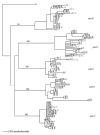
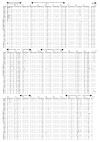
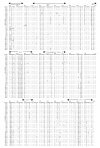
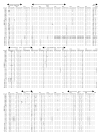
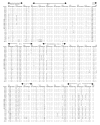
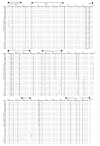
References
-
- Abrams EJ, Wiener J, Carter R, Kuhn L, Palumbo P, Nesheim S, Lee F, Vink P, Bulterys M. Maternal health factors and early pediatric antiretroviral therapy influence the rate of perinatal HIV-1 disease progression in children. Aids. 2003;17:867–877. doi: 10.1097/00002030-200304110-00012. - DOI - PubMed
-
- Connor EM, Sperling RS, Gelber R, Kiselev P, Scott G, O'Sullivan MJ, VanDyke R, Bey M, Shearer W, Jacobson RL, Jimenez E, O'Neill E, Bazin B, Delfraissy J-F, Culnane M, Coombs R, Elkins M, Moye J, Stratton P, Balsley J. Reduction of maternal-infant transmission of human immunodeficiency virus type 1 with zidovudine treatment. Pediatric AIDS Clinical Trials Group Protocol 076 Study Group. N Engl J Med. 1994;331:1173–1180. doi: 10.1056/NEJM199411033311801. - DOI - PubMed
-
- Frenkel LM, Wagner LE, 2nd, Demeter LM, Dewhurst S, Coombs RW, Murante BL, Reichman RC. Effects of zidovudine use during pregnancy on resistance and vertical transmission of human immunodeficiency virus type 1. Clin Infect Dis. 1995;20:1321–1326. - PubMed
Publication types
MeSH terms
Substances
Associated data
- Actions
- Actions
- Actions
- Actions
- Actions
- Actions
- Actions
- Actions
- Actions
- Actions
- Actions
- Actions
- Actions
- Actions
- Actions
- Actions
- Actions
- Actions
- Actions
- Actions
- Actions
- Actions
- Actions
- Actions
- Actions
- Actions
- Actions
- Actions
- Actions
- Actions
- Actions
- Actions
- Actions
- Actions
- Actions
- Actions
- Actions
- Actions
- Actions
- Actions
- Actions
- Actions
- Actions
- Actions
- Actions
- Actions
- Actions
- Actions
- Actions
- Actions
- Actions
- Actions
- Actions
- Actions
- Actions
- Actions
- Actions
- Actions
- Actions
- Actions
- Actions
- Actions
- Actions
- Actions
- Actions
- Actions
- Actions
- Actions
- Actions
- Actions
- Actions
- Actions
- Actions
- Actions
- Actions
- Actions
- Actions
- Actions
- Actions
- Actions
- Actions
- Actions
- Actions
- Actions
- Actions
- Actions
- Actions
- Actions
- Actions
- Actions
- Actions
- Actions
- Actions
- Actions
- Actions
- Actions
- Actions
- Actions
- Actions
- Actions
- Actions
- Actions
- Actions
- Actions
- Actions
- Actions
- Actions
- Actions
- Actions
- Actions
- Actions
- Actions
- Actions
- Actions
- Actions
- Actions
- Actions
- Actions
- Actions
- Actions
- Actions
- Actions
- Actions
- Actions
- Actions
- Actions
- Actions
- Actions
- Actions
- Actions
- Actions
- Actions
- Actions
- Actions
- Actions
- Actions
- Actions
- Actions
- Actions
- Actions
- Actions
- Actions
- Actions
- Actions
- Actions
- Actions
- Actions
- Actions
- Actions
- Actions
- Actions
- Actions
- Actions
- Actions
- Actions
- Actions
- Actions
Grants and funding
LinkOut - more resources
Full Text Sources
Other Literature Sources
Medical
Molecular Biology Databases
Miscellaneous

